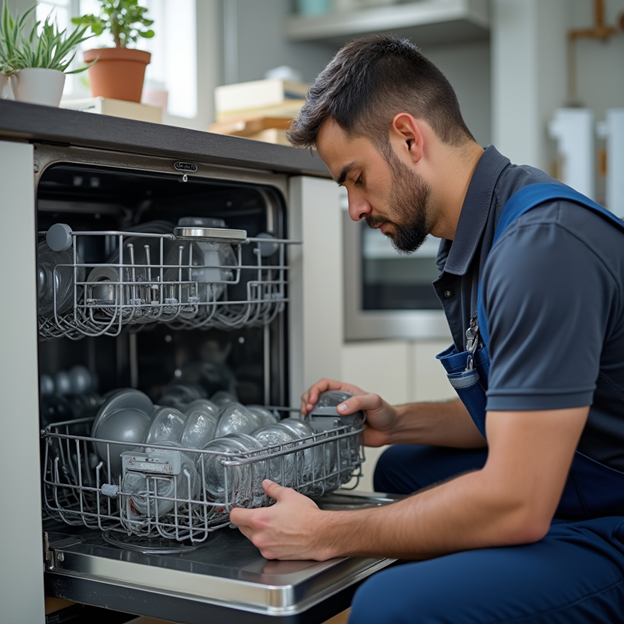Sometimes we may encounter problems such as watering water on the floor of the dishwasher. In this article, we are going to thoroughly examine the common cause of this problem and ways to resolve them.
1. Embroidery filter cramps, first and perhaps the most important reason
The discharge filter in the Bush Dishwasher is a vital piece that prevents the entry of food particles and other waste into the drain pump. The location of the filter varies depending on the dishwasher model and is usually located at the bottom and inner part of the machine. To access it, check your dishwasher manual. If the filter is blocked, the water cannot be properly discharged and as a result it will accumulate on the floor of the dishwasher. To fix this problem, first remove the filter from the dishwasher. To do this, you usually have to rotate it in the opposite direction and then pull it out. Then rinse the filter with warm water and mild detergent such as dishwashing liquid. Use a soft brush or toothbrush to completely clean the filter and make sure that there is no food or fat particles left. After cleaning, return the filter to your place and make sure it is locked properly.
2. Discharge hose; Check the water exit path
The drain hose transmits the water that comes out of the dishwasher to the sewage. This hose may be blocked over time due to the accumulation of food particles, fats or sediments and prevent water from exit. Discharge hose cramps is one of the most common reasons for the accumulation of water on the floor of the dishwasher. To review and fix this problem, first turn the dishwasher off and power out. Then remove the drain hose from the dishwasher and sewage. Be careful that the remaining water does not fall out in the drain hose. To clean the hose, you can use a long brush or a narrow rod. Slowly dip it into the hose and remove the blocking particles. You can also use a water and vinegar or dishwasher opening solution to clean the hose. After cleaning, rinse the hose thoroughly and connect it to the dishwasher and sewage again. Make sure the hose is firmly and firmly attached to prevent water leakage.
1. Discharge pump
The discharge pump is responsible for pumping water from the dishwasher to sewage. This piece is located at the bottom of the dishwasher and may require opening of the front or back panel of the machine. Discharge pump failure can occur for a variety of reasons, including stuck in the pump impeller, pump engine failure, or obstruction of the pump outlet. To check the drain pump, first turn the dishwasher off and power out. Then access the drain pump and check it. If the food or hair particles are stuck in the pump butterfly, remove them carefully. Make sure the pump impeller rotates easily and there is no obstacle. If the drain pump still does not work, it may need to be replaced. Replacement of the drain pump is usually specialized and it is best to do it by experienced technician.
1. Sewage pipe
Sometimes it may be a problem with the sewage pipe, not the dishwasher. If the sewage pipe is blocked, the water cannot be removed from the dishwasher and as a result it will accumulate in the machine. To check the sewage pipe, you can use a manual opener or a springs opening. Dip the opener into the sewage pipe and rotate it to remove the cramps. You can also use chemical opening solutions. However, be careful about using these materials and carefully read the instructions on the packaging. If you do not fix the problem, you may need the help of a specialist plumbing.
1. Detergents
Excessive use of detergents can cause high foaming and as a result of the accumulation of water on the floor of the dishwasher. High foam can block the water drainage path and disrupt the device’s function. Always use the recommended amount of detergent specified by the dishwasher manufacturer. Usually the appropriate amount of detergent is listed in the dishwasher’s manual. You can also use a dishwasher for tablet, powder or liquid. These detergents are specifically designed for use in the dishwasher and prevent excessive foam.
1. Layout of containers
Incorrect layout of containers in the dishwasher can prevent water from reaching all parts of the machine and thus not cleanse the containers and the water accumulates on the floor. The properly arranged container can block the flow of water and cause water to accumulate in some parts. To prevent this problem, place the dishes properly in the dishwasher and make sure that the water can reach all parts easily. Place large containers such as pots and pan at the bottom of the dishwasher and place smaller containers such as glasses and plates at the top. Avoid placing the dishes together and make sure there is enough distance between the containers so that the water can flow easily.
1. Water sensor
The water sensor in the dishwasher is responsible for detecting water levels in the machine. The sensor sends water level information to the electronic control board and adjusts the control board based on this information, discharge pump performance and other components. If the water sensor breaks down, it may send incorrect information to the control board, resulting in excessive water in the machine or the water will not be properly discharged. To check the water sensor, first turn off the dishwasher and power out. Then access the water sensor and check it. If the water sensor is dirty or damaged, clean or replace it. Replacing the water sensor is usually a specialized task and it is best to do it by experienced technician.
1. Electric valve
The valve is responsible for controlling the inlet water flow to the dishwasher. This valve adjusts the amount of input water to the device according to the electronic control board commands. If the valve breaks down, the water may enter the machine too much and thus accumulate on the floor. Electric valve failure can be caused by sediment, clogging or electrical problems. To check the electric valve, first turn the dishwasher off and pull the electricity. Then access the electric valve and check it. Clean it if the electric valve is dirty or blocked. Replace the valve if necessary. Electric valve replacement is also usually a specialized task and it is best to do it by experienced technician.
1. Electronic board

The electronic board is responsible for controlling all the functions of the dishwasher. This piece gives the necessary instructions to other components such as drain pumps, electric valves and motors. If the electronic board breaks down, it may send incorrect instructions to other components, resulting in problems such as water accumulation on the floor of the machine. Electronic board failure can be caused by electrical fluctuations, moisture or electronic components. Reviewing and repairing an electronic board requires special expertise and equipment and should be done by a specialist technician.
1. Review of possible leakage
Water leakage is one of the less common causes, but it is still important in the accumulation of water in the dishwasher. Leakage can occur from different parts such as door, pipe fittings, or even detergent tank. If leakage, water will gradually accumulate on the floor of the dishwasher and can cause more serious problems over time. To check the leakage, first turn the dishwasher off and pull off the electricity. Then open the dishwasher door and look around it carefully. Make sure there is no leakage from the door or seams. Next, check the inlet and outlet pipe connections and make sure there are no leaks or leaks. Also check the detergent tank and make sure the detergent is properly located and does not leak. If you see any leakage, first try to eliminate it by tightening the joints or replacing the damaged parts. If you fail, it is best to contact a specialist technician.
Important Tips for Preventing Water Problems in Bush Dishwasher:
- Wipe the food particles from them before placing the dishes in the dishwasher.
- Regularly clean the drainage filter and the drain hose.
- Use the right amount of detergent.
- Put the dishes properly in the dishwasher.
- Avoid picking dishes together.
- Periodic the dishwasher periodically.
If you see any problems in the dishwasher, first check the simpler items such as filters, hoses and layouts. If you do not fix the problem, see a specialist technician.
In the end, remember that the dishwasher is a complex device and its troubleshooting and repair requires knowledge and expertise. If the problem is still there or does not have enough experience in the field, we recommend you get a specialist and experienced technician. You can also receive specialized services Bush’s dishwasher repairRefer to authorized agencies.
Source Link
